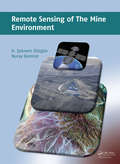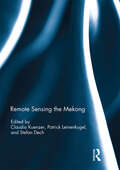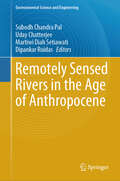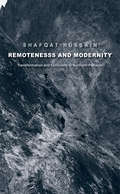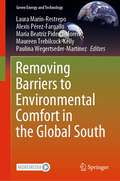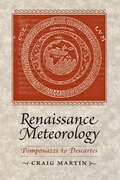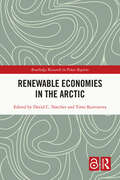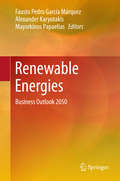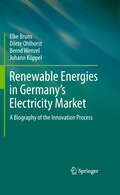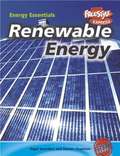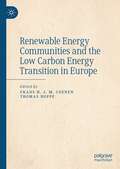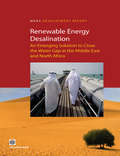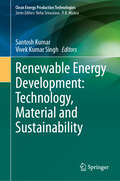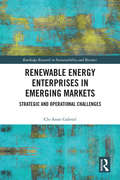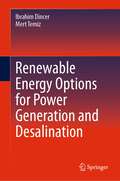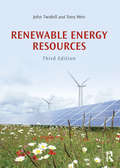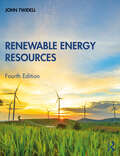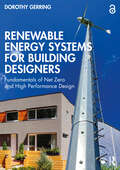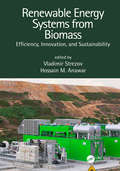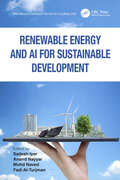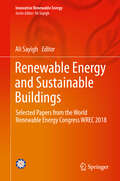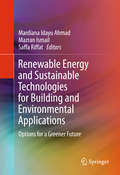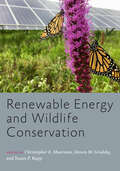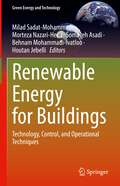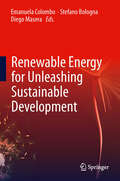- Table View
- List View
Remote Sensing of the Mine Environment
by H. Şebnem Düzgün Nuray DemirelA guide for students and professionals, this introductory course book covers the basic principles of remote sensing and its applications in mine environment monitoring. Building from a reader’s basic knowledge of mine monitoring, it teaches how to implement remote sensing techniques and how to interpret the acquired data for different purposes. Following a general introduction to remote sensing principles and image analysis, mine subsidence monitoring, slope stability monitoring, reclamation planning and implementation, and post-closure mine and land use analysis are explained and illustrated. With the help of case studies, the techniques and tools presented are demonstrated. With an increasing importance of sustainable mining, this accurate text is intended for the education of university students in mining, civil, geological and environmental engineering. Researchers and professionals in these disciplines may find it beneficial as well to guide their professional monitoring investigations.
Remote Sensing the Mekong
by Claudia Kuenzer Stefan Dech Patrick LeinenkugelThe Mekong Basin in Southeast Asia is one of the largest international river basins in the world. Its abundant natural resources are shared by six riparian countries and provide the basis for the livelihoods of more than 75 million people. However, ongoing socio-economic growth and related anthropogenic interventions impact the region’s ecosystems, and there is an urgent need for the monitoring of the basin's land surface dynamics. Remote sensing has evolved as a key tool for this task, allowing for up-to-date analyses and regular monitoring of environmental dynamics beyond physical or political boundaries and at various temporal and spatial scales. This book serves as a forum for remote-sensing scientists with an interest in the Mekong River Basin to present their recent basin-related works as well as applied case studies of the region. A broad range of sensors from high to medium resolution, and from multispectral to SAR systems, are applied, covering topics such as land cover/land use classification and comparison, time series analyses of climate variables, vegetation structure and vegetation productivity, as well as studies on flood mapping or water turbidity monitoring. This book was originally published as a special issue of the International Journal of Remote Sensing.
Remotely Sensed Rivers in the Age of Anthropocene (Environmental Science and Engineering)
by Uday Chatterjee Subodh Chandra Pal Martiwi Diah Setiawati Dipankar RuidasThis book offers a geospatial technology approach to data mining techniques, data analysis, modeling, risk assessment, and visualization, as well as management strategies in many elements of river basin risks. This book investigates cutting-edge techniques based on open source software and R statistical programming Google Earth Engine and modeling in modern artificial intelligence techniques, with a particular emphasis on recent trends in data mining techniques and robust modeling in river basin management. It includes significant issues such as geomorphological hazards, climate change, catastrophic natural disasters, meteorological and agricultural drought monitoring, landslides or mudslides (mudflow), floods and flash floods, soil erosion, and land degradation. This book's contents are of interest to earth and environmental scientists, professionals, and policymakers. The book examines spatial modeling, risk evaluation of a drainage basin in the domain of environmental and social issues, management, and associated research. Due to poorly understood climate change and unclear man-made activity, there are several problems and uncertainties in studying earth's environmental circumstances, making it exceedingly difficult to analyze and make knowledgeable judgments. Many difficulties, on the other hand, are caused by mismanagement of present and future land, water, and forestry resources. It is also critical to use new technology and methods to improve and reinforce environmental protection. The link between the three devices, namely remote sensing (RS), GIS, and the R programming interface, is acknowledged in this respect. Land conservation measures, soil and water quality control, and new rules should all rely on correct measurements and predictions, and three technologies (RS, GIS, and R) and open access quantitative forecasting methodologies help with climate change and better management regulations. Nonetheless, this book serves as a feasible framework for studying current breakthroughs in geospatial artificial intelligence technologies and their relevance to the planet's environmental and socioeconomic concerns in a single volume.
Remoteness and Modernity
by Shafqat HussainThis groundbreaking book is the first sustained anthropological inquiry into the idea of remote areas. Shafqat Hussain examines the surprisingly diverse ways the people of Hunza, a remote independent state in Pakistan, have been viewed by outsiders over the past century. He also explores how the Hunza people perceived British colonialists, Pakistani state officials, modern-day Westerners, and others, and how the local people used their remote status strategically, ensuring their own interests were served as they engaged with the outside world.
Removing Barriers to Environmental Comfort in the Global South (Green Energy and Technology)
by Alexis Pérez-Fargallo Laura Marín-Restrepo María Beatriz Piderit-Moreno Maureen Trebilcock-Kelly Paulina Wegertseder-MartínezThis book describes how comfort, energy and climate change in developing countries and vulnerable sectors of the population relate to buildings.The building sector is currently facing significant challenges connected to energy consumption, energy poverty and climate change effects. When studied in developing countries and vulnerable sectors of the population, these factors, which are commonplace in the tropics and the southern hemisphere, are interlinked and share a critical component: environmental comfort. Although progress has been made in environmental comfort through research and the development of standards and policies at the international level, in the Global South, where the countries with the highest levels of income inequality are concentrated, environmental comfort has its own characteristics and challenges that prevent a clear understanding from the established vision of the Global North.This book presents research, theories and techniques related to Thermal comfort, Indoor air quality, Visual comfort, and Acoustic comfort and its relationship with energy use and energy efficiency, seeking to address different barriers to environmental comfort. It shows how to improve the way buildings are designed and operated to promote healthier environmental conditions and more sustainable construction, by presenting studies and reflections carried out in the target geographical area: the Global South. In this way, this book contributes to developing the concept of environmental comfort, visualising how progress has been made in understanding it from a tropical and southern perspective, and posing common challenges.The book is intended for engineers, architects, and researchers of the built environment who are interested in environmental comfort and its influence on energy consumption, energy poverty, and other related factors in the Global South context. It is also a useful resource for decision-makers and public policy developers concerned with the indoor comfort of buildings. Moreover, the book aims to provide guidance for those in developing countries by gathering existing knowledge in the field for the tropics and southern hemisphere climatic and sociocultural contexts, allowing us to move forward in this subject with actions and proposed solutions that fit our particular needs.
Renaissance Meteorology: Pomponazzi to Descartes
by Craig MartinCraig Martin takes a careful look at how Renaissance scientists analyzed and interpreted rain, wind, and other natural phenomena like meteors and earthquakes and their impact on the great thinkers of the scientific revolution.Martin argues that meteorology was crucial to the transformation that took place in science during the early modern period. By examining the conceptual foundations of the subject, Martin links Aristotelian meteorology with the new natural philosophies of the seventeenth century. He argues that because meteorology involved conjecture and observation and forced attention to material and efficient causation, it paralleled developments in the natural philosophies of Descartes and other key figures of the scientific revolution. Although an inherently uncertain endeavor, forecasting the weather was an extremely useful component not just of scientific study, but also of politics, courtly life, and religious doctrine. Martin explores how natural philosophers of the time participated in political and religious controversies by debating the meanings, causes, and purposes of natural disasters and other weather phenomena. Through careful readings of an impressive range of texts, Martin situates the history of meteorology within the larger context of Renaissance and early modern science. The first study on Renaissance theories of weather in five decades, Renaissance Meteorology offers a novel understanding of traditional natural philosophy and its impact on the development of modern science.
Renewable Economies in the Arctic (Routledge Research in Polar Regions)
by Timo Koivurova David C. NatcherThis book offers multidisciplinary perspectives on renewable economies in the Arctic and how these are being supported scientifically, economically, socially, and politically by Arctic states. The economic development of the Arctic region is witnessing new, innovative trends which hold promise for the sustainable development of the region. This book discusses the emerging forms of renewable economies to understand where intellectual and technological innovations are being made. It draws on the expertise of scholars from across the Arctic and provides the reader with a foundation of knowledge to identify the unique challenges of the region and explore opportunities to unlock the immense potential of renewable resources to boost the region’s economy. This book offers a holistic Arctic perspective against the backdrop of prevailing social, economic, and climatic challenges. With critical insights on the economic state of play and the role of renewable resources in the development of the Arctic region, this book will be a vital point of reference for Arctic scholars, communities, and policy makers.
Renewable Energies
by Fausto Pedro García Márquez Alexander Karyotakis Mayorkinos PapaeliasThis book provides a comprehensive overview of current renewable energy technologies and their basic principles. It also addresses the financial aspects of renewable energy projects and analyzes their profitability, covering the most relevant topics for engineers, economists, managers and scientists who are actively involved in renewable energy research and management. The authors are professionals and researchers who are active in the industry, and supplement the main content with revealing case studies and best-practice examples.
Renewable Energies in Germany’s Electricity Market
by Bernd Wenzel Johann Köppel Dörte Ohlhorst Elke BrunsThis cross-sectional, interdisciplinary study traces the "history of innovation" of renewable energies in Germany. It features five renewable energy sectors of electricity generation: biomass, photovoltaic, wind energy, geothermal energy and hydropower. The study tracks the development of the respective technologies as well as their contribution to electricity generation. It focuses on driving forces and constraints for renewable energies in the period between 1990 and today.
Renewable Energy (Energy Essentials)
by Nigel Saunders Steven ChapmanThe book tells you all about the energy crisis the world is facing. But don't panic--it also explains how we can use other forms of energy to continue living our modern lives. It describes how ideas and technology can be used and developed to provide us with energy in the future.
Renewable Energy Communities and the Low Carbon Energy Transition in Europe
by Thomas Hoppe Frans H. J. M. CoenenThis volume addresses renewable energy communities, and in particular renewable energy cooperatives (REScoops), in the context of the revised EU Renewables Directive. It provides a comprehensive account of the history and development of the renewable energy community movement in over six different countries of continental Europe. It addresses their visions, strategy, organisation, agency, and more particularly the challenges they encounter. This is of particular importance to gain more understanding into how renewable energy communities fare in domestic energy markets where they are confronted with regime institutions, structures and incumbents’ agency that tend to favour maintaining of the status quo while blocking attempts to empower and institutionalise renewable energy communities as market entrants having a disruptive, radical green and localist agenda. This volume will be an invaluable reference for academics and practitioners with an interest in social innovation in sustainable transitions, the role of community energy in energy markets, their agency, as well as an outlook to the impact that the EU Renewables Directive may have to change national legislation and policy frameworks to create a level playing field that is essentially more fair and beneficial to renewable energy communities.
Renewable Energy Desalination
by Bekele Debele NegewoThe Middle East and North Africa (MENA) Region is one of the most water stressed regions in the world. Water scarcity has already become a challenge to development in many of the countries. Due to increasing population and Projected climate change impacts, MENA's annual water demand gap is projected to grow five-fold by 2050, from today's 42 Km3 to 200 km3 by 2050. Despite its extreme scarcity, water is managed poorly. Inefficiencies are common in the agriculture, municipal and industrial systems; and many utilities are financially unsustainable. As a result, countries overexploit their fossil aquifers-and use desalination by fossil fuel-to meet the water demand gap. Desalination already plays a critical role in MENA's water supply portfolio. However, desalination is costly, energy intensive and has environmental impacts. On current trends, the projection is that, by 2050, Saudi Arabia and many other countries in the Region will consume for desalination most of the oil that they produce. Overexploitation of fossil aquifers is not sustainable. Neither is the use of fossil fuel for desalination to meet the growing water gap sustainable. This book outlines the challenges in terms of water (and also in terms of energy) that countries in the Region face and analyzes the scope of available options to address the growing water gap. The book estimates MENA's water gap today and into the future-until 2050; and presents a methodology to prioritize options to bridge the water gap, using the 'marginal cost of water' approach. The book also assesses the viability of renewable energy desalination as an important option to close the Region's water gap. The book compares the economic cost of desalination using fossil fuel and renewable energy sources, in particular the Concentrated Solar Power (CSP). The book also provides recommendations as to how CSP based desalination could ensure sustainable water supply for the Region.
Renewable Energy Development: Technology, Material and Sustainability (Clean Energy Production Technologies)
by Santosh Kumar Vivek Kumar SinghThis edited volume is a comprehensive guide to understanding and harnessing the power of renewable energy for a sustainable future. In a world dealing with the urgent need to combat climate change and reduce our dependence on fossil fuels, this book provides a new perspective on renewable energy. It is filled with cutting-edge research and practical insights, exploring the technologies, advanced materials, and sustainability practices driving the renewable energy revolution. Renewable energy resources are developing the latest advancements in solar, wind, hydro, geothermal, biomass, tidal, and wave energy technologies. This book is unique and opens a new window on classic renewable energy sources as well as new developments in technology, advanced material innovation, and sustainability aspects leading with various factors such as energy storage, transmission, institutional and economic factors, renewable energy application in smart cities, building and other solar thermal applications, environmental aspects, electrical energy generation, and climate change mitigation potential to achieve net-zero targets. This book is of interest to teachers, researchers, climate change scientists, capacity builders, and policymakers. Additionally, the book serves as an additional reading material for undergraduate and graduate students of sustainable energy, engineering, material science, and environmental sciences. National and international energy, sustainable and material scientists, managers, and policymakers will also find this to be a useful read.
Renewable Energy Enterprises in Emerging Markets: Strategic and Operational Challenges (Routledge Research in Sustainability and Business)
by Cle-Anne GabrielThis book highlights the challenges faced by renewable energy enterprises (REEs) in emerging markets, by reflecting on the enterprises&’ own stories and experiences. Research into REEs has focused largely on successful businesses and business models, and developed markets. With significant opportunities for renewable energy enterprise in emerging markets, this book presents a unique business-level perspective. It highlights the key barriers and outlines the strategic and operational solutions for success articulated by the entrepreneurs themselves. The research draws on interviews with entrepreneurs in twenty-eight emerging markets, including Barbados, Cambodia, Chile, Ghana, Indonesia, India, Kenya, South Africa and Uganda. The book concludes by summarising the key solutions for success and illustrating how successful REEs put them into practice. This book will be of great interest to students and scholars of renewable energy, sustainable business and the sustainability agenda in emerging markets.
Renewable Energy Options for Power Generation and Desalination
by Ibrahim Dincer Mert TemizThis book examines simultaneous power generation and desalination driven by renewable energy systems. It covers all renewables, including solar, wind, geothermal, hydro, ocean and biomass as well as waste sources. This book also includes thermodynamic fundamentals, concepts, and system design, analysis and assessment studies, along with illustrative examples and case studies, for sustainable applications. It further provides an ample opportunity to learn more about cutting-edge technologies and newly developed systems for power generation and desalination.
Renewable Energy Resources
by John Twidell Tony WeirRenewable Energy Resources is a numerate and quantitative text covering the full range of renewable energy technologies and their implementation worldwide. Energy supplies from renewables (such as from biofuels, solar heat, photovoltaics, wind, hydro, wave, tidal, geothermal, and ocean-thermal) are essential components of every nation’s energy strategy, not least because of concerns for the local and global environment, for energy security and for sustainability. Thus in the years between the first and this third edition, most renewable energy technologies have grown from fledgling impact to significant importance because they make good sense, good policy and good business. This Third Edition is extensively updated in light of these developments, while maintaining the book’s emphasis on fundamentals, complemented by analysis of applications. Renewable energy helps secure national resources, mitigates pollution and climate change, and provides cost effective services. These benefits are analysed and illustrated with case studies and worked examples. The book recognises the importance of cost effectiveness and efficiency of end-use. Each chapter begins with fundamental scientific theory, and then considers applications, environmental impact and socio-economic aspects before concluding with Quick Questions for self-revision and Set Problems. The book includes Reviews of basic theory underlying renewable energy technologies, such as electrical power, fluid dynamics, heat transfer and solid-state physics. Common symbols and cross-referencing apply throughout; essential data are tabulated in appendices. An associated eResource provides supplementary material on particular topics, plus a solutions guide to Set Problems. Renewable Energy Resources supports multi-disciplinary master degrees in science and engineering, and specialist modules in first degrees. Practising scientists and engineers who have not had a comprehensive training in renewable energy will find it a useful introductory text and a reference book.
Renewable Energy Resources
by John TwidellRenewable Energy Resources is a numerate and quantitative text. It covers the many renewables technologies implemented worldwide by harnessing sustainable resources, mitigating pollution and climate change, and providing cost effective services. This fourth edition is extensively updated by John Twidell with global developments as underpinned by fundamental analysis and illustrated by case studies and worked examples. Efficiency of end-use and cost-effectiveness is emphasized. Each chapter begins with fundamental scientific theory, and then considers applications, environmental impact and socio-economic aspects, before concluding with Quick Questions for self-revision, Problems and new Exercises. Basic theory underlying the technologies is covered in succinct Reviews of electrical power, fluid dynamics, heat transfer and solid-state physics. Common symbols and cross-referencing apply throughout; essential data are tabulated in Appendices. Renewable Energy Resources supports multidisciplinary master’s degrees in science and engineering, and specialist modules at undergraduate level. Practicing scientists and engineers will find it a useful introductory text and reference book.
Renewable Energy Systems for Building Designers: Fundamentals of Net Zero and High Performance Design
by Dorothy GerringRenewable Energy Systems for Building Designers presents a comprehensive introduction to the latest resources and technologies used in high performance and net zero energy buildings, with a practical focus on the design and integration of these systems. This textbook and convenient reference offers a single-source guide to renewable technologies, balancing broad knowledge with the details of implementation crucial for successful sustainable design. It equips students and professionals with foundations and critical information needed to confidently plan for and meet the highest standards of energy efficiency in new construction and retrofitted buildings. Part I of the book establishes key principles of renewable systems, power production, and design for climate, introducing energy modeling and measurements of performance. Part II focuses in more depth on renewable energy systems, including photovoltaics, heat pumps, solar thermal, and more. Dedicated chapters break down the fundamental concepts behind each renewable technology and present guidelines for configuration and installation including system requirements, equipment specification, sizing, and location of components. Part III discusses topics relevant across renewable systems, including energy storage, control and monitoring, and cost/payback calculation. Part IV comprises case studies of exemplary renewable energy projects. Features: Covers resources and technologies including photovoltaics, solar thermal hot water, heat pumps, biomass, wind and microhydro turbines, marine renewable energy, deep cycle rechargeable batteries, and system controllers. Compiles up-to-date, essential information on designing with renewable systems in one location, organized by technology for easy reference. Presents clear explanations of all concepts and system aspects, using US/SI units and full-color diagrams and illustrations throughout. Features case studies of renewable energy systems in completed projects, demonstrating a range of climate specific applications. Includes study questions, a comprehensive guide to terminology and acronyms, spreadsheets for calculations, system sizing worksheets, and additional online resources. Renewable Energy Systems for Building Designers: Fundamentals of Net Zero and High Performance Design will serve as an essential introduction and enduring reference for students of architecture, engineering, construction, and building science. Equally valuable as a professional resource, it will quickly become the go-to guide for energy efficient design for practitioners in these areas.
Renewable Energy Systems from Biomass: Efficiency, Innovation and Sustainability
by Vladimir Strezov and Hossain M. AnawarNew innovations are needed for the invention of more efficient, affordable, sustainable and renewable energy systems, as well as for the mitigation of climate change and global environmental issues. In response to a fast-growing interest in the realm of renewable energy, Renewable Energy Systems: Efficiency, Innovation and Sustainability identifies a need to synthesize relevant and up-to-date information in a single volume. This book describes a systems approach to renewable energy, including technological, political, economic, social and environmental viewpoints, as well as policies and benefits. This unique and concise text, encompassing all aspects of the field in a single source, focuses on truly promising innovative and affordable renewable energy systems. Key Features: Focuses on innovations in renewable energy systems that are affordable and sustainable Collates the most relevant and up-to-date information on renewable energy systems, in a single and unique volume Discusses lifecycle assessment, cost and availability of systems Emphasizes bio-related topics Provides a systems approach to the renewable energy technologies and discusses technological, political, economic, social, and environmental viewpoints as well as policies
Renewable Energy and AI for Sustainable Development (Innovations in Intelligent Internet of Everything (IoE))
by Fadi Al-Turjman Anand Nayyar Mohd Naved Sailesh IyerElectronic device usage has increased considerably in the past two decades. System configurations are continuously requiring upgrades; existing systems often become obsolete in a matter of 2–3 years. Green computing is the complete effective management of design, manufacture, use, and disposal, involving as little environmental impact as possible. This book intends to explore new and innovative ways of conserving energy, effective e-waste management, and renewable energy sources to harness and nurture a sustainable eco-friendly environment. This book: • Highlights innovative principles and practices using effective e-waste management and disposal • Explores artificial intelligence based sustainable models • Discovers alternative sources and mechanisms for minimizing environmental hazards • Highlights successful case studies in alternative sources of energy • Presents solid illustrations, mathematical equations, as well as practical in-the-field applications • Serves as a one-stop reference guide to stakeholders in the domain of green computing, e-waste management, renewable energy alternatives, green transformational leadership including theory concepts, practice and case studies • Explores cutting-edge technologies like internet of energy and artificial intelligence, especially the role of machine learning and deep learning in renewable energy and creating a sustainable ecosystem • Explores futuristic trends in renewable energy This book aims to address the increasing interest in reducing the environmental impact of energy as well as its further development and will act as a useful reference for engineers, architects, and technicians interested in and working with energy systems; scientists and engineers in developing countries; industries, manufacturers, inventors, universities, researchers, and interested consultants to explain the foundation to advanced concepts and research trends in the domain of renewable energy and sustainable computing. The content coverage of the book is organized in the form of 11 clear and thorough chapters providing a comprehensive view of the global renewable energy scenario, as well as how science and technology can play a vital role in renewable energy.
Renewable Energy and Sustainable Buildings: Selected Papers from the World Renewable Energy Congress WREC 2018 (Innovative Renewable Energy)
by Ali SayighThis book contains selected papers presented during the World Renewable Energy Network’s 28thanniversary congress at the University of Kingston in London. The forum highlighted the integration of renewables and sustainable buildings as the best means to combat climate change. In-depth chapters written by the world’s leading experts highlight the most current research and technological breakthroughs and discuss policy, renewable energy technologies and applications in all sectors – for heating and cooling, agricultural applications, water, desalination, industrial applications and for the transport sectors.Presents cutting-edge research in green building and renewable energy from all over the world;Covers the most up-to-date research developments, government policies, business models, best practices and innovations;Contains case studies and examples to enhance practical application of the technologies.
Renewable Energy and Sustainable Technologies for Building and Environmental Applications
by Mardiana Idayu Ahmad Mazran Ismail Saffa RiffatThis diverse resource on renewableenergy and sustainable technologies highlights the status, state of the art,challenges, advancements and options in areas such as energy recovery systems,turbine ventilators, green composites, biofuels andbio-resources for energy production, wind energy, integrated energy-efficientsystems, thermal energy storage, natural ventilation & day-lightingsystems, and low carbon technologies for building and environmentalapplications. It is designed to serve as a reference book for students,researchers, manufacturers and professionals working in these fields. Theeditors have gathered articles from world-leading experts that clearlyillustrate key areas in renewable energy and sustainability. The distinct roleof these technologies in future endeavors is stressed by taking into accountthe opportunities to contribute with new approaches, methods and directions forbuilding and environmental applications. The in-depth discussion presented inthis book will give readers a clear understanding of every important aspect ofeach technology's applications, optimum configuration, modifications,limitations and their possible improvements.
Renewable Energy and Wildlife Conservation (Wildlife Management and Conservation)
by Christopher E. Moorman Steven M. Grodsky Susan RuppBrings together disparate conversations about wildlife conservation and renewable energy, suggesting ways these two critical fields can work hand in hand.Renewable energy is often termed simply "green energy," but its effects on wildlife and other forms of biodiversity can be quite complex. While capturing renewable resources like wind, solar, and energy from biomass can require more land than fossil fuel production, potentially displacing wildlife habitat, renewable energy infrastructure can also create habitat and promote species health when thoughtfully implemented.The authors of Renewable Energy and Wildlife Conservation argue that in order to achieve a balanced plan for addressing these two crucially important sustainability issues, our actions at the nexus of these fields must be directed by current scientific information related to the ecological effects of renewable energy production. Synthesizing an extensive, rapidly growing base of research and insights from practitioners into a single, comprehensive resource, contributors to this volume• describe processes to generate renewable energy, focusing on the Big Four renewables—wind, bioenergy, solar energy, and hydroelectric power• review the documented effects of renewable energy production on wildlife and wildlife habitats• consider current and future policy directives, suggesting ways industrial-scale renewables production can be developed to minimize harm to wildlife populations• explain recent advances in renewable power technologies• identify urgent research needs at the intersection of renewables and wildlife conservationRelevant to policy makers and industry professionals—many of whom believe renewables are the best path forward as the world seeks to meet its expanding energy needs—and wildlife conservationists—many of whom are alarmed at the rate of renewables-related habitat conversion—this detailed book culminates with a chapter underscoring emerging opportunities in renewable energy ecology.Contributors: Edward B. Arnett, Brian B. Boroski, Regan Dohm, David Drake, Sarah R. Fritts, Rachel Greene, Steven M. Grodsky, Amanda M. Hale, Cris D. Hein, Rebecca R. Hernandez, Jessica A. Homyack, Henriette I. Jager, Nicole M. Korfanta, James A. Martin, Christopher E. Moorman, Clint Otto, Christine A. Ribic, Susan P. Rupp, Jake Verschuyl, Lindsay M. Wickman, T. Bently Wigley, Victoria H. Zero
Renewable Energy for Buildings: Technology, Control, and Operational Techniques (Green Energy and Technology)
by Behnam Mohammadi-Ivatloo Morteza Nazari-Heris Somayeh Asadi Houtan Jebelli Milad Sadat-MohammadiThe book covers practical applications and experimental results of integrating renewable energy technologies, energy storage facilities, and intelligent control and operation techniques into building energy systems. It introduces practical approaches to improving the energy systems of buildings in order to reduce energy consumption and cost. Renewable Energy for Buildings is suitable for retrofit engineers, energy engineers, and professionals, as well as researchers and developers in electrical engineering, architectural engineering, and mechanical engineering. Moreover, it can be used by undergraduate and graduate students to become familiar with the most recent developments in building energy systems.Examines the most recent developments in building energy systems;Looks at practical applications and theoretical aspects; Includes case studies.
Renewable Energy for Unleashing Sustainable Development
by Emanuela Colombo Stefano Bologna Diego MaseraThe book analyzes energy technologies, business models and policies to promote sustainable development. It proposes a set of recommendations for further activities and networking on access to energy and renewable energies and promotes an integrated approach to sustainable resource management. The book discusses access to energy, as a precondition for socio-economic progress. It depicts the global dimension of the challenge in terms of access to electricity and other forms of energy in developing countries. The three main interlinked topics related to energy and sustainable growth are separately discussed: appropriate technologies for modern energy services, business models for the development of new energy markets, and policies to support new energy systems. The description of activities and programmes of some public and private Italian stakeholders is also included.
